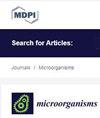胎儿肠道微生物群母体起源的时间调查
IF 4.1
2区 生物学
Q2 MICROBIOLOGY
引用次数: 0
摘要
有益微生物及其副产品在子宫内的定植或沉积可能是通过各种机制进行的,例如血源性传播或从生殖道上升。利用高通量测序技术,我们已经确定了新生儿胎粪中的微生物成分。虽然这些成分的生物量较低,往往不足以进行培养,但微生物DNA特征的存在可能会促进胎儿出生前的免疫耐受或表观遗传调控。本研究旨在调查新生儿第一次粪便微生物组的母体来源。通过主成分分析将从 21 对母婴组合中采集的母体阴道和肛门样本与新生儿第一道胎粪微生物组成进行比较。结果表明,在整个孕期,第二和第三个孕期的母体肠道微生物群与阴道微生物群样本之间的相似程度最高,这表明母体肠道微生物群可能在孕期转移到胎儿肠道。这项研究揭示了母体微生物物种在子宫内向后代潜在转移的起源和时间。本文章由计算机程序翻译,如有差异,请以英文原文为准。
Temporal Investigation of the Maternal Origins of Fetal Gut Microbiota
In utero colonization or deposition of beneficial microorganisms and their by-products likely occurs through various mechanisms, such as hematogenous spread or ascension from the reproductive tract. With high-throughput sequencing techniques, the identification of microbial components in first-pass neonatal meconium has been achieved. While these components are low-biomass and often not abundant enough to culture, the presence of microbial DNA signatures may promote fetal immune tolerance or epigenetic regulation prior to birth. The aim of this study was to investigate the maternal source of the neonatal first-pass meconium microbiome. Maternal vaginal and anal samples collected from twenty-one maternal–infant dyad pairs were compared via principal component analysis to first-pass neonatal meconium microbial compositions. Results demonstrated the greatest degree of similarity between the maternal gut microbiome in the second and third trimesters and vaginal microbiome samples across pregnancy, suggesting that the maternal gut microbiota may translocate to the fetal gut during pregnancy. This study sheds light on the origin and timing of the potential transfer of maternal microbial species to offspring in utero.
求助全文
通过发布文献求助,成功后即可免费获取论文全文。
去求助
来源期刊

Microorganisms
Medicine-Microbiology (medical)
CiteScore
7.40
自引率
6.70%
发文量
2168
审稿时长
20.03 days
期刊介绍:
Microorganisms (ISSN 2076-2607) is an international, peer-reviewed open access journal which provides an advanced forum for studies related to prokaryotic and eukaryotic microorganisms, viruses and prions. It publishes reviews, research papers and communications. Our aim is to encourage scientists to publish their experimental and theoretical results in as much detail as possible. There is no restriction on the length of the papers. The full experimental details must be provided so that the results can be reproduced. Electronic files and software regarding the full details of the calculation or experimental procedure, if unable to be published in a normal way, can be deposited as supplementary electronic material.
 求助内容:
求助内容: 应助结果提醒方式:
应助结果提醒方式:


